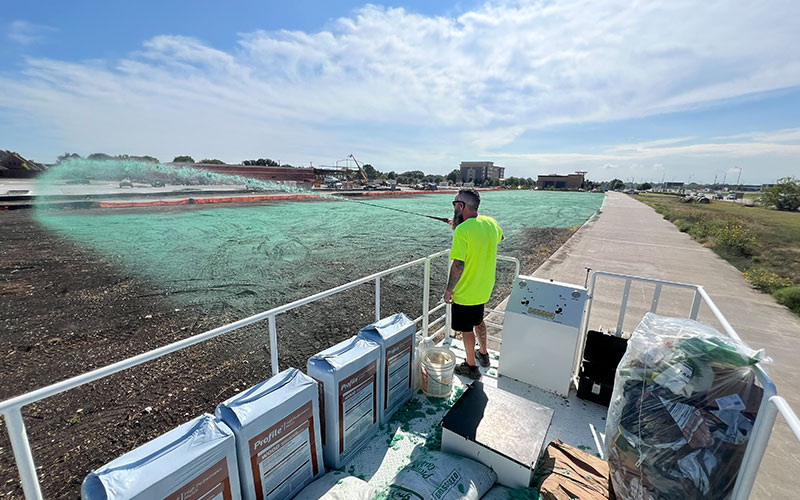Timing is everything when it comes to successful landscaping, and hydromulching is no exception. Choosing the optimal season for hydromulching can significantly impact seed germination, growth rates, and the overall success of your project. In this blog post, we’ll provide guidance on the best times of the year to undertake hydromulching, how seasonal conditions affect growth, and tips for maximizing results in each season.
Understanding the Importance of Timing in Hydromulching
Hydromulching is an effective method for establishing vegetation quickly and efficiently. However, seeds need the right environmental conditions to germinate and grow. Factors such as temperature, moisture, daylight hours, and weather patterns play crucial roles in the success of your hydromulching project.
Optimal Seasons for Hydromulching
While hydromulching can be performed year-round in some regions, certain seasons offer better conditions for seed germination and growth. Below, we’ll explore the advantages and considerations for hydromulching in each season.
1. Spring Hydromulching
Why Spring Is Ideal
- Optimal Temperatures: As temperatures rise, soil warms up, creating favorable conditions for seed germination.
- Increased Moisture: Spring showers provide natural irrigation, reducing the need for supplemental watering.
- Longer Daylight Hours: Extended daylight promotes photosynthesis, supporting robust plant growth.
Considerations
- Soil Preparation: Ensure the soil is dry enough to work with after winter thaw but moist enough to support seed germination.
- Weed Competition: Spring is also when weeds emerge; consider pre-emergent treatments to minimize competition.
Tips for Success
- Early Start: Begin hydromulching as early in the spring as weather permits to give seeds a head start.
- Monitor Weather: Be mindful of late frosts, which can damage young seedlings.
2. Fall Hydromulching
Why Fall Is Favorable
- Stable Temperatures: Cooler temperatures reduce heat stress on seedlings.
- Reduced Weed Growth: Fewer competing weeds emerge in the fall.
- Soil Warmth: Soil retains heat from summer, aiding in seed germination.
Considerations
- Shorter Growing Season: Seeds must germinate and establish before the first hard frost.
- Moisture Levels: Fall rains can aid in seed establishment but be cautious of heavy downpours that may cause erosion.
Tips for Success
- Timing Is Crucial: Hydromulch early in the fall to allow sufficient time for establishment.
- Choose Appropriate Seeds: Opt for cool-season grasses or plants that germinate quickly.
3. Summer Hydromulching
Challenges of Summer
- High Temperatures: Extreme heat can stress seeds and seedlings, inhibiting growth.
- Increased Water Needs: Evaporation rates are higher, requiring more frequent irrigation.
- Risk of Drought: Water restrictions may limit irrigation options.
When Summer Hydromulching Works
- Irrigation Availability: If you have access to consistent irrigation, hydromulching in summer can be successful.
- Heat-Tolerant Species: Use seed mixes that include drought-resistant and heat-tolerant varieties.
Tips for Success
- Hydrate Thoroughly: Maintain a regular watering schedule to keep the mulch moist.
- Monitor for Pests: Warm conditions can attract pests; keep an eye out for infestations.
4. Winter Hydromulching
Challenges of Winter
- Cold Temperatures: Low temperatures inhibit seed germination.
- Frost and Snow: Freezing conditions can damage seeds and young plants.
- Limited Daylight: Shorter days reduce photosynthesis opportunities.
When Winter Hydromulching Is Considered
- Dormant Seeding: In some cases, hydromulching can be done when seeds remain dormant until spring.
- Erosion Control: Applying hydromulch in winter can protect soil from erosion, with germination occurring in spring.
Tips for Success
- Use Dormant Seeds: Select seeds suitable for dormant seeding practices.
- Prepare for Delayed Growth: Understand that visible results won’t appear until warmer temperatures return.

Regional Considerations
Hydromulching in Texas
- Climate Variability: Texas has diverse climates—from humid subtropical to semi-arid—affecting the optimal hydromulching season.
- Best Times: Generally, late spring and early fall are ideal for hydromulching in Texas due to moderate temperatures and sufficient rainfall.
- Local Expertise: Consult with professionals like Bledsoe Hydromulch who understand regional conditions and can tailor solutions accordingly.
How Seasonal Timing Affects Growth
Temperature Impact
- Germination Rates: Seeds have optimal temperature ranges for germination; too cold or too hot can delay or prevent sprouting.
- Growth Speed: Moderate temperatures promote faster growth, while extremes can slow development.
Moisture Availability
- Natural Precipitation: Aligning hydromulching with seasons of regular rainfall reduces reliance on irrigation.
- Evaporation Rates: Cooler seasons reduce evaporation, keeping the mulch moist longer.
Daylight Hours
- Photosynthesis: Longer days in spring and summer provide more sunlight for photosynthesis, aiding growth.
- Seasonal Adjustments: Seed mixes may be adjusted based on available daylight to ensure adequate development.
Maximizing Hydromulching Success in Any Season
Soil Preparation
- Test and Amend: Regardless of the season, proper soil preparation enhances seed germination and growth.
- Ensure Proper Drainage: Avoid waterlogging in wetter seasons by ensuring adequate drainage.
Seed Selection
- Seasonal Seeds: Choose seed varieties suited to the planting season and regional climate.
- Blend Varieties: Use a mix of seeds to increase the chances of successful establishment.
Irrigation Planning
- Supplemental Watering: Be prepared to irrigate during dry periods, especially in summer.
- Water Conservation: Use efficient irrigation methods to conserve water while maintaining moisture levels.
Professional Guidance
- Expert Consultation: Work with experienced professionals who can provide tailored advice and services.
- Customized Solutions: Professionals can adjust hydromulch mixtures and techniques based on seasonal conditions.
Conclusion
Timing your hydromulching project to align with optimal seasonal conditions can significantly enhance the success of your landscaping efforts. While spring and fall generally offer the best conditions in terms of temperature and moisture, with proper planning and expert guidance, hydromulching can be effective in any season.
Ready to Plan Your Hydromulching Project?
At Bledsoe Hydromulch, we have the expertise to help you navigate seasonal considerations and achieve outstanding results year-round. Our team will assess your specific needs and regional climate to determine the best timing and approach for your project.
Contact us today at (214) 784-5402 or email ashley@bledsoehydromulch.com to schedule a free consultation. Let’s work together to create a vibrant, healthy landscape that stands the test of time.
Bledsoe Hydromulch—Expert Timing for Optimal Growth, Every Season of the Year.
